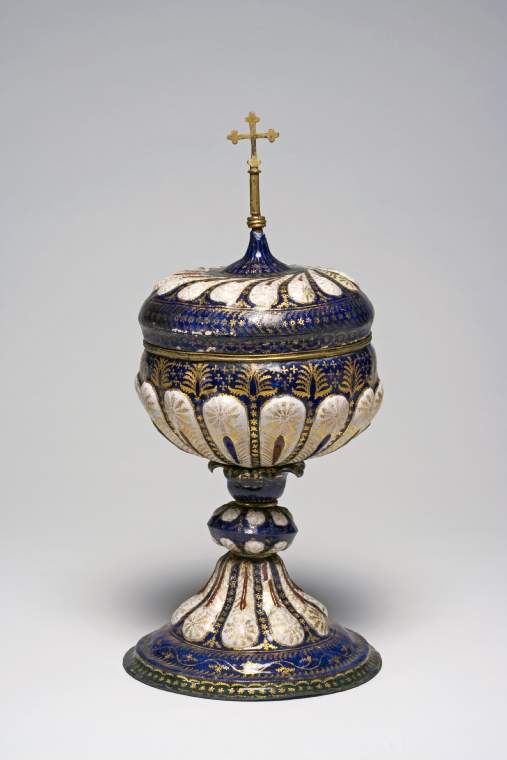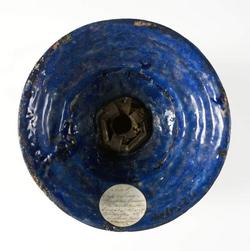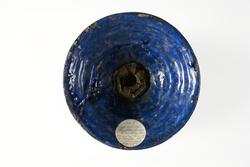Current Location: In storage
Maker(s)
Maker:
Unknown
(Possibly)
Entities
Categories
Description
Copper, enamelled and gilt
Copper, raised, enamelled in dark blue, dark green, dark red, and white enamels, and gilded with gold leaf; brass finial. The ciborium stands on a stepped and domed circular foot rising into a lobed stem supporting a separately made depressed globular knop with lobes above and below the equator, above which is a rounded calyx with everted petals on which the bowl rests. The deep rounded bowl is lobed round its lower part and has a gilt-copper rim. The domed cover has swirling gadroons on the top, and in the centre a finial in the form of a cross. The ground of both parts is blue with a dark green border round the foot, and dark green petals on the calyx. The blue areas are decorated in gold with palmettes, flower heads and fleurs-de-lys.The lobes on the foot, knop, and cover, and the gadroons on the bowl are white; with stylized flower and foliage ornament in gold with red and blue highlights on the lobed and gadrooned areas. Round the edge of the foot there is a continuous spray of foliage, a row of scallops and a row of flowerheads all in gold.
Notes
History note: Florence where bought in 1857 by C. Redfern; W. Bateman and T. Bateman, Lomberdale House, Youlgrave, Derbyshire; sold Sotheby, Wilkson & Hodge, 14 April 1893, The Bateman Heirlooms. Catalogue of the First Portion of the Valuable and Important Collection of Works of Art & Antiquity, formed by the late W. Bateman, Esq., & T. Bateman, Esq. Of Lomberdale House, Youlgrave, Co. Derby, p. 6, lot 22; sold to Frank McClean for £61.
Legal notes
Frank McClean Bequest
Measurements and weight
Height: 33.5 cm
Acquisition and important dates
Method of acquisition: Bequeathed
(1904)
by
McClean, Frank
Dating
15th Century, Late-16th Century, Early
Production date:
circa
AD 1500
Note
A ciborium is a liturgical vessel in which the consecrated Host (bread or wafers) for the Eucharist is kept
Enamels of this type have been attributed to Venice since at least the 1850s, but recent comparisons of scientific analyses of Venetian glass and the enamels indicates that this is unlikely. Possible alternatives are elsewhere in the Veneto, Florence or elsewhere in Tuscany, see Documentation Warren (2019), Verità, et al (2018) Barbe et al (2019)
School or Style
Renaissance
People, subjects and objects depicted
Components of the work
Decoration
composed of
enamel
( dark blue, dark green, dark red, and white)
gold
Finial
composed of
brass (alloy)
( probably)
Cup And Cover
composed of
copper
Bowl
Diameter 14.9 cm
Foot
Diameter 15.8 cm
Techniques used in production
Raising
: Copper, raised, enamelled in dark blue, dark green, dark red, and white, and gilded
Enamelling
Inscription or legends present
Inscription present: circular paper label
- Text: N.1.187/Cup & Cover of/Venetian Enamel/of the 15 or 16 century/Bought at Florence/by C. Redfern 1857/of extreme Value/& Importance/T.B.
- Location: On underside of foot
- Method of creation: Hand-written in faded black ink
- Type: Label
References and bibliographic entries
-
The Bateman Heirlooms
page(s): 6
-
Fitzwilliam Museum, McClean Bequest, Catalogue of the Mediaeval Ivories, Enamels, Jewellery, Gems and Miscellaneous Objects Bequeathed to the Museum by Frank McClean, M.A., F.R.S.
page(s): 116
-
I Rami smaltati detti Veneziani del Rinascinmento italiano. Les Cuivres émaillés dits Vénitiens de la Renaissance italienne, 2 vols
page(s): 69, 176
-
Catalogue de la collection d'objets d'art et de curiosité composant le Musée Jules de Vicq
page(s): 30
-
The Walters Art Gallery, Catalogue of the Painted Enamels of the Renaissance
page(s): 4-7
-
Enamels the XII to the XVI Century, a special exhibition at The Martin d’Arcy Gallery of Art
-
The So-called Venetian Enamelled Copper Artworks of the italian Renaissance: the Technology and Provenance of the Enamels - an Analytical approach
page(s): 233-54
-
Venetian Enamels: The Case for Florence
page(s): 55-69
Identification numbers
Accession number: M.25 & A-1904
Primary reference Number: 119204
Stable URI
Audit data
Created: Saturday 6 August 2011
Updated: Monday 29 April 2024
Last processed: Thursday 14 August 2025
Associated departments & institutions
Owner or interested party:
The Fitzwilliam Museum
Associated department:
Applied Arts

 IIIF Manifest
IIIF Manifest






